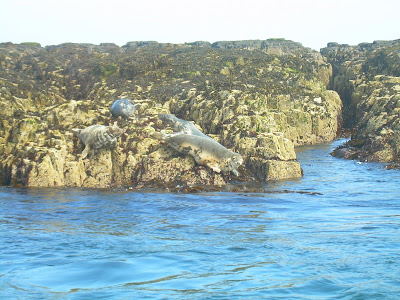We took a boat tour (along with a lot of other tourists!) to the islands, which lasted about two and a half hours. We saw tons of birds and seals and got to get out and walk on Staple Island to see a lot of nesting birds close-up, including puffins! I was surprised to learn that puffins nest underground. They dig burrows in the turf and pop in and out of them with their beaks full of fish. The island was covered with birds and it was a truly unique, noisy, and smelly, experience.
 Puffins at the top of the rocky cliffs on one of the Farne Islands. Look closely to see a puffin taking a leap off the rock!
Puffins at the top of the rocky cliffs on one of the Farne Islands. Look closely to see a puffin taking a leap off the rock! Grey seals. The tour boat got quite close to the rocks where the seals were and some dove into the water while others just raised their eyebrows at us.
Grey seals. The tour boat got quite close to the rocks where the seals were and some dove into the water while others just raised their eyebrows at us.  Once off the boat on Staple Island we were able to see the masses of nesting birds up close. The island was roped off so you could only walk in a certain area to protect the birds (and likely to protect the visitors from falling off the cliffs!). The birds you see the most of are the guillemots, which look like penguins in their tuxedo black and white coloring, and which lay their pear-shaped eggs directly on the high rocks.
Once off the boat on Staple Island we were able to see the masses of nesting birds up close. The island was roped off so you could only walk in a certain area to protect the birds (and likely to protect the visitors from falling off the cliffs!). The birds you see the most of are the guillemots, which look like penguins in their tuxedo black and white coloring, and which lay their pear-shaped eggs directly on the high rocks. Matt gets some footage of the puffins. Note the puffin flying overhead!
Matt gets some footage of the puffins. Note the puffin flying overhead! Puffins around their turf burrows. As we stood and watched we could see them come in and out of their burrows, which were small holes in the ground.
Puffins around their turf burrows. As we stood and watched we could see them come in and out of their burrows, which were small holes in the ground.  Matt got this great close-up of a strutting puffin. They are pretty funny looking walking around on land, and after getting a running start and leaping off the ground they make a loud fluttering noise when they fly!
Matt got this great close-up of a strutting puffin. They are pretty funny looking walking around on land, and after getting a running start and leaping off the ground they make a loud fluttering noise when they fly! Cormorants about to feed their hungry chicks. The cormorants only nest on a few of the islands, in big groups.
Cormorants about to feed their hungry chicks. The cormorants only nest on a few of the islands, in big groups.  Kittiwakes nesting on outcroppings in the cliffs. Look closely to see the little grey chick in the nest.
Kittiwakes nesting on outcroppings in the cliffs. Look closely to see the little grey chick in the nest. Looking out back towards the mainland from Staple Island. The specks you see are all flying birds, most of them puffins! The puffins only nest on islands with turf.
Looking out back towards the mainland from Staple Island. The specks you see are all flying birds, most of them puffins! The puffins only nest on islands with turf.  Our boat was the "Glad Tidings II". There was such a huge tide (the tide is always very large here, however with the summer solstice on the way the tides were extreme that day) that the captain had all the passengers pile into the front covered area of the boat to try to lift the props, and had to make two tries to get the boat into the harbor. He did succeed, finally, and we made our way back up the stairs and onto the wharf. On to our next adventure!
Our boat was the "Glad Tidings II". There was such a huge tide (the tide is always very large here, however with the summer solstice on the way the tides were extreme that day) that the captain had all the passengers pile into the front covered area of the boat to try to lift the props, and had to make two tries to get the boat into the harbor. He did succeed, finally, and we made our way back up the stairs and onto the wharf. On to our next adventure!





















